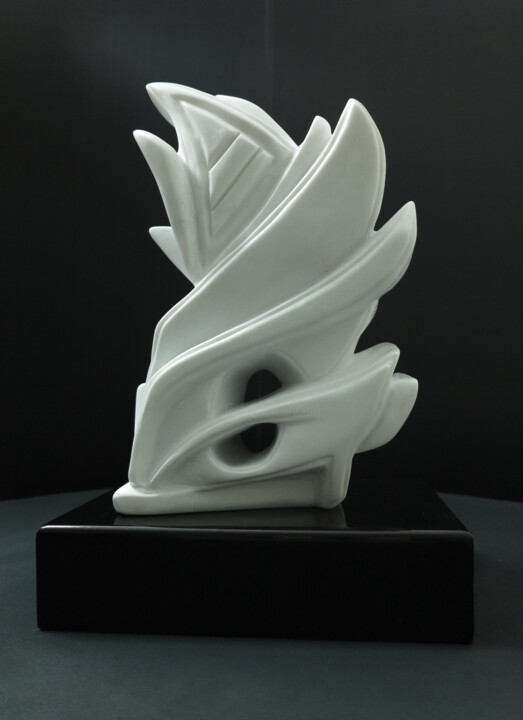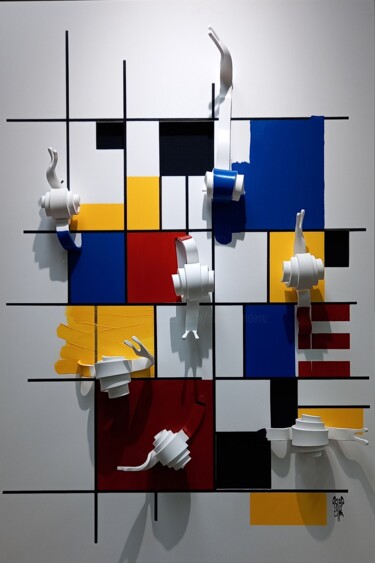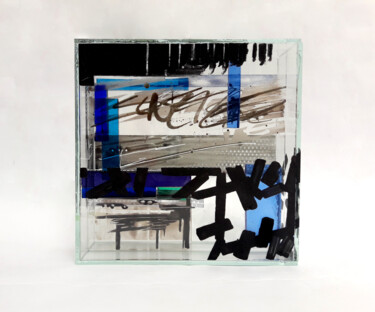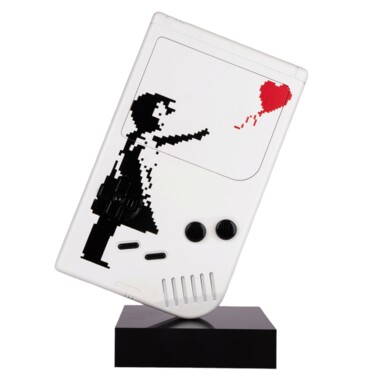189 Sculture contemporanee originali in vendita:
Come definire stile Street Art ?
Street Art is visual art produced in public spaces for viewing by the general public and is intended to spread a social and political statement. It has been referred to as "guerrilla art," "post-graffiti," "neo-graffiti," and "independent art." Street art is seen as the zenith of democratic art because it can be viewed by anybody and is not owned. Artists have introduced this unusual and democratic work into institutions and galleries throughout the past few decades, garnering recognition on a global scale and popularity in the "traditional" art world. The city and its residents have an impact on street artists' environment and sources of inspiration. Their main themes frequently examine ideas of popular culture, ads, cartoons, and urban settings. Street art is full of inventiveness and constantly looking for new techniques, supports, and materials, from the abstract to the figurative.
The fundamental idea behind street art is that everyone should have the opportunity to create art and have it seen by others, regardless of their race, age, gender, economic status, or other characteristics. It also believes that art should be accessible rather than hidden away inside galleries, museums, and private collections. Even though some street artists may make sculptures or installations, they are more well recognized for using uncommon art materials like wheat paste, spray paint, stencils, and stickers.
The most well-known artists of today developed their reputations on the streets. Graffiti artists like Keith Haring and Jean-Michel Basquiat, whose works were found on public walls as well as in galleries and museums, had a big impact on later generations of artists, particularly Banksy and Fairey. Street art has historically had a tense relationship with the art world as a whole due to its roots in illegal activity and distinctive interest in subversion, political, and social action.
Street Art sculpture
In sculpture, Street Art is a movement and a form of artistic expression characteristic of the late twentieth century, early twenty-first. Many sculptors have marked the history of this movement through his handling of volumes: this is particularly the case of Mark Jenkins and his hooded figures, but also of Isaac Cordal and his miniatures characters very critical of our social development, or the Gregos parisian with his persons making faces. Around the world, Street art sculpture continues to be a popular category of art and many of its creators have achieved renown and mainstream success.
Street Art Sculptors
Mark Jenkins (born 1970)
American artist Mark Jenkins creates sculptural street installations. Jenkins uses the "street as a theater" in his street art, allowing his sculptures to interact with the environment. With his hyperrealistic sculptures that he places in the streets across Europe and the United States, Mark Jenkins explores how people see the world. The staging is often uncomfortable and the faces of the people are frequently obscured. Since he wraps live figures in plastic films and tape, his technique is likewise hidden. The "cast" is then cut out, put back together without the figure, dressed, and given realistic features like hands and hair.
Gregos (born 1972)
French street artist Gregos began displaying his face on the buildings in Paris. He creates a reproduction of his face with his tongue out or smiling that he paints and adheres to the walls of Paris using his own 3D concept, which he designed utilizing all the techniques he had learned and refined over the years. Each face serves as a kind of self-portrait for the day, expressing the humor of the wearer and his past, present, and future.
The street art concept by Gregos is effective at encouraging conversation between the faces and among spectators. More than 500 faces have been installed so far, largely in Paris but also in other French cities and cities across the globe, including Europe, the United States, Japan, and South America.
Isaac Cordal (born 1974)
Isaac Cordal is a Spanish Galician artist who specializes in miniature art. His creations feature miniature animals built of cement, which is often thought of as the mark of civilization, and are positioned in unexpected places like gutters and puddles. Due to its small size (about 15 cm), finding them requires careful attention. They are frequently depicted in ordinary activities, and the setting choice can introduce new dimensions to the action. They typically highlight how ludicrous our current world is. The artist uses the sculptures as a metaphor to analyze politics, bureaucracy, and power.
Christiaan Nagel (born 1982)
Christiaan Nagel is a British street artist known for his oversized mushroom sculptures made from polyurethane which he places high up on buildings. They reach as far as Los Angeles, Cape Town, Berlin, Barcelona, London, New York, and Cape Town. These polyurethane mushrooms come in various sizes and individual samples or flocks. The artist claims that although mushrooms naturally develop, they require ideal weather and environmental circumstances, such as original artistic and scientific concepts.
Scopri le sculture contemporanee di Street Art su Artmajeur
Le sculture di Street Art contemporanea sono un tipo di opera d’arte originale che ha guadagnato immensa popolarità negli ultimi anni. I principali tipi di supporto utilizzati per queste sculture sono muri, edifici e spazi pubblici. I materiali utilizzati includono vernice spray, stencil, legno, metallo e plastica, tra gli altri. Ciò che rende unica questo tipo di opera d’arte è la sua capacità di portare l’arte nelle strade e renderla accessibile a tutti.

©2023 2mé / Blondeau
Origini e Storia
Il movimento Graffiti, che ebbe inizio negli anni ’70, fu una significativa risposta alla mancanza di rappresentanza delle comunità emarginate nel mondo dell’arte. Gli artisti del Graffiti utilizzavano gli spazi pubblici per esprimersi e veicolare i loro messaggi. Questo movimento portò all’emergere dello Street Art negli anni ’80. Gli artisti di strada iniziarono a creare non solo graffiti, ma anche murales, adesivi, manifesti e sculture utilizzando materiali come metallo, legno e cemento. Le sculture contemporanee di Street Art continuano a evolversi, con nuovi artisti e stili che emergono continuamente.

©2023 Sand
Evoluzioni di questi lavori nel mercato dell’arte contemporanea
Le sculture di street art contemporanea hanno subito una significativa evoluzione negli ultimi anni. Ciò che un tempo era un movimento underground ha guadagnato riconoscimento mainstream, con artisti che esplorano nuovi materiali e tecniche per creare Opere di forte impatto. Questo ha portato ad un aumento dell’interesse nel mercato dell’arte contemporanea, con collezionisti e investitori che cercano questi pezzi unici e stimolanti. L’importanza di queste sculture risiede nella loro capacità di sfidare le tradizionali concezioni dell’arte, creando un dialogo tra l’artista e lo spettatore. Inoltre, la loro collocazione in spazi pubblici significa che hanno il potere di trasformare il paesaggio urbano, rendendo l’arte più accessibile e inclusiva. Man mano che il movimento delle sculture di street art continua ad evolversi, sarà affascinante vedere come gli artisti navigano la tensione tra successo commerciale e integrità artistica.

©2023 Shelby Artista rappresentato da Studio Tangerine
Artisti Famosi Correlati
Gli Artisti Contemporanei specializzati in sculture di street art sono molto richiesti per le loro approcci unici e innovativi a questa forma d’arte popolare. Questi artisti utilizzano una varietà di tecniche e materiali per creare sculture sbalorditive che catturano l’essenza della vita urbana.
Uno degli artisti è uno scultore noto per il suo lavoro intricato e altamente dettagliato. Ha grandi competenze nel lavorare con il metallo e le sue sculture spesso incorporano oggetti trovati e altri materiali per creare un effetto visivo sorprendente. Un altro artista è noto per le sue sculture audaci e colorate che incorporano elementi di graffiti e street art. Il suo lavoro è altamente riconoscibile e ha guadagnato un vasto seguito tra gli appassionati di street art.
Un altro artista è conosciuto per le sue installazioni su larga scala che trasformano gli ambienti urbani in opere d’arte. Le sue sculture spesso incorporano elementi dell’architettura e del paesaggio circostante, creando un’integrazione senza soluzione di continuità tra arte e ambiente costruito. Un altro artista è noto per il suo uso di materiali non convenzionali, come plastica riciclata e altri rifiuti, per creare sculture whimsical e stimolanti che commentano questioni di sostenibilità e ambientalismo.
Nel complesso, questi artisti contemporanei sono altamente abili nella loro arte e portano una prospettiva unica alle sculture di street art. Che lavorino con metallo, graffiti o materiali non convenzionali, stanno spingendo i confini di ciò che è possibile in questa forma d’arte emozionante e dinamica.

©2023 Sagrasse
Sculture di Street Art contemporanea degne di nota
Le sculture contemporanee di street art sono diventate una forma significativa di arte urbana, catturando l’attenzione del pubblico in tutto il mondo. Ecco alcune delle sculture di street art più famose e le loro descrizioni:
The Fearless Girl - Kristen Visbal - 2017 The Fearless Girl è una scultura in bronzo di una giovane ragazza che si tiene con sicurezza le mani sui fianchi, fissando il famoso Wall Street Charging Bull. La scultura è stata creata da Kristen Visbal e installata nel 2017 come simbolo di emancipazione femminile e diversità di genere a Wall Street.
Balancing Act - Roa - 2018 L’artista belga Roa ha creato Balancing Act, una scultura di un gigantesco roditore che si bilancia sulla coda, nel 2018 a Melbourne, in Australia. L’opera è stata ispirata dalla fiorente popolazione di ratti della città e dalla loro capacità di adattarsi all’ambiente urbano.
Love Me - Curtis Kulig - 2011 Love Me è una scultura delle parole "Love Me" scritte in lettere grandi e audaci. Creata dall’artista Curtis Kulig nel 2011, la scultura è stata installata in città di tutto il mondo, tra cui New York, Parigi e Tokyo. L’opera è un messaggio di amore e positività per il pubblico.
KAWS: Holiday - KAWS - 2019 KAWS: Holiday è una serie di cinque massive sculture create dall’artista americano KAWS nel 2019. Le sculture raffigurano il suo iconico personaggio Companion che si riposa in varie località del mondo, come Hong Kong, Giappone e Stati Uniti. L’opera è una visione ludica e fantasiosa di viaggio e avventura.
The Knotted Gun - Carl Fredrik Reuterswärd - 1980 The Knotted Gun, noto anche come Non-Violence, è una scultura in bronzo di una pistola con la canna annodata. Creata dall’artista svedese Carl Fredrik Reuterswärd nel 1980, l’opera è diventata un simbolo di pace e non-violenza in tutto il mondo, ed è installata in varie località, tra cui la sede delle Nazioni Unite a New York.
In conclusione, le sculture di street art contemporanea sono diventate una forma importante di arte pubblica, portando messaggi di potenziamento, positività e pace alle città di tutto il mondo. Queste opere d’arte sono una testimonianza del potere dell’arte di ispirare e provocare pensieri.

Cyborg Corrigé
Scultura - artwork_cat. | 63x35x30 cm

Eric Vialla (Tweak)
Scultura - Metalli | 38x130x44 cm

Jordan Jeffray
Scultura - Acrilico | 95x28x22 cm

Carole Carpier
Scultura - Resina | 21,5x6x8,5 cm
































